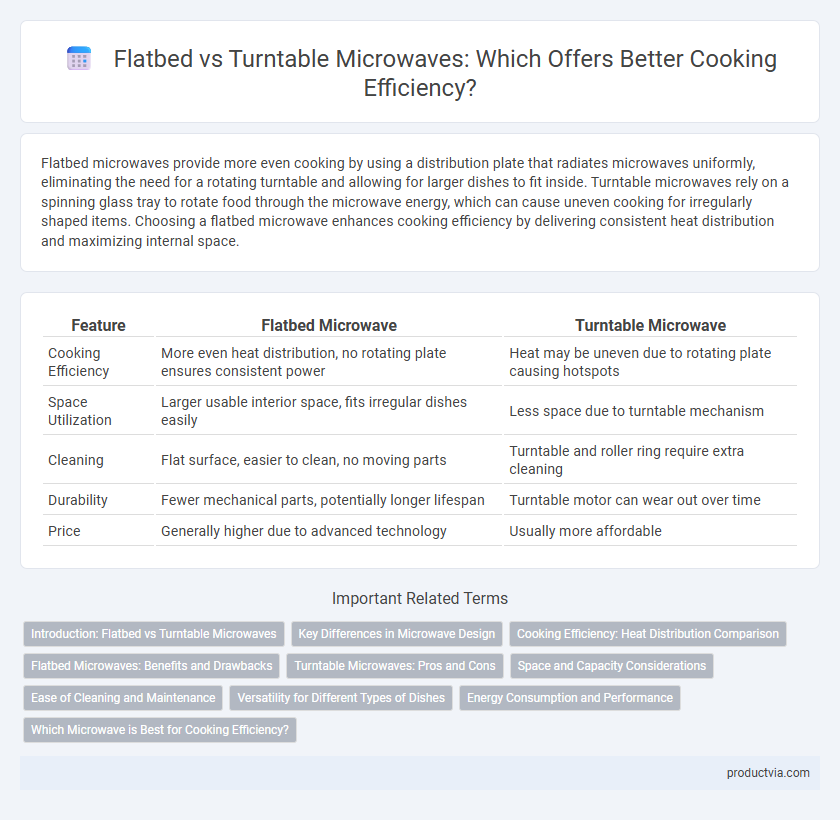Flatbed microwaves provide more even cooking by using a distribution plate that radiates microwaves uniformly, eliminating the need for a rotating turntable and allowing for larger dishes to fit inside. Turntable microwaves rely on a spinning glass tray to rotate food through the microwave energy, which can cause uneven cooking for irregularly shaped items. Choosing a flatbed microwave enhances cooking efficiency by delivering consistent heat distribution and maximizing internal space.
Table of Comparison
| Feature | Flatbed Microwave | Turntable Microwave |
|---|---|---|
| Cooking Efficiency | More even heat distribution, no rotating plate ensures consistent power | Heat may be uneven due to rotating plate causing hotspots |
| Space Utilization | Larger usable interior space, fits irregular dishes easily | Less space due to turntable mechanism |
| Cleaning | Flat surface, easier to clean, no moving parts | Turntable and roller ring require extra cleaning |
| Durability | Fewer mechanical parts, potentially longer lifespan | Turntable motor can wear out over time |
| Price | Generally higher due to advanced technology | Usually more affordable |
Introduction: Flatbed vs Turntable Microwaves
Flatbed microwaves utilize a rotating flat surface beneath the food, enabling more even cooking by eliminating the traditional turntable mechanism. Turntable microwaves rely on a rotating plate to move food through the microwave's energy field, which can cause uneven heating on irregularly shaped dishes. Choosing between flatbed and turntable microwaves impacts cooking efficiency, with flatbed models generally offering more consistent heat distribution and greater interior space flexibility.
Key Differences in Microwave Design
Flatbed microwaves feature a rotating antenna beneath a flat cooking surface, providing more even heat distribution and greater usable interior space compared to turntable microwaves. Turntable microwaves use a rotating glass turntable to ensure food rotates through microwave waves, which can cause uneven heating if the dish size exceeds the turntable diameter. The flatbed design enhances cooking efficiency by eliminating the need for manual food rotation and accommodating larger or irregularly shaped dishes more effectively.
Cooking Efficiency: Heat Distribution Comparison
Flatbed microwaves use a uniform heating system that eliminates the need for a rotating turntable, providing more even heat distribution and maximizing cooking efficiency by allowing larger and irregularly shaped dishes to receive consistent heat. Turntable microwaves rely on rotation to distribute microwaves evenly, but they can create hot and cold spots due to uneven wave patterns and restrictions on dish size. As a result, flatbed microwaves generally offer superior cooking performance with faster, more uniform heating compared to traditional turntable models.
Flatbed Microwaves: Benefits and Drawbacks
Flatbed microwaves offer improved cooking efficiency with even heat distribution due to the absence of a rotating turntable, allowing larger or unevenly shaped dishes to cook uniformly. They provide more usable interior space and easier cleaning since the flatbed design eliminates the need for a spinning plate. However, flatbed microwaves often come at a higher price point and may have a less familiar user experience compared to traditional turntable models.
Turntable Microwaves: Pros and Cons
Turntable microwaves offer even cooking by continuously rotating food, reducing hot spots and ensuring consistent heat distribution. They accommodate various dish sizes but may have limited interior space due to the rotating mechanism. However, the moving turntable can cause noise and might require frequent cleaning to avoid food buildup underneath.
Space and Capacity Considerations
Flatbed microwaves offer greater cooking capacity and uniform heating by eliminating the turntable mechanism, allowing for larger and more evenly heated dishes. Turntable microwaves typically have reduced usable space due to the rotating tray, which can limit the size of cookware and lead to uneven heating. Choosing between a flatbed and turntable microwave depends on kitchen space availability and the need for accommodating various dish sizes efficiently.
Ease of Cleaning and Maintenance
Flatbed microwaves offer a smooth, flat interior surface that simplifies cleaning and maintenance by eliminating the turntable, which can accumulate food debris and grease. Turntable microwaves require regular removal and cleaning of the rotating plate and cavity edges, often trapping spills underneath the turntable mechanism. The streamlined design of flatbed microwaves enhances both cooking efficiency and ease of upkeep, reducing time spent on maintenance and improving overall hygiene.
Versatility for Different Types of Dishes
Flatbed microwaves provide enhanced versatility for different types of dishes by evenly distributing microwaves without the need for a turntable, allowing for larger or irregularly shaped containers. Turntable microwaves rely on a rotating tray to promote even cooking, but this limits the size and shape of cookware that can be used. Flatbed technology supports diverse cooking needs and improves overall cooking efficiency by maximizing usable interior space.
Energy Consumption and Performance
Flatbed microwaves deliver more even cooking and increased energy efficiency by using a rotating stirrer instead of a turntable, which eliminates the need to rotate food manually. Turntable microwaves often consume more energy due to uneven heating, requiring longer cook times and occasional manual repositioning for consistent results. Optimizing cooking performance with a flatbed design reduces energy consumption by ensuring uniform microwave distribution and faster cooking cycles.
Which Microwave is Best for Cooking Efficiency?
Flatbed microwaves provide more even cooking by using a static, rotating antenna that distributes microwave energy uniformly across the cavity, eliminating the need for turntables and maximizing usable space. Turntable microwaves rely on a rotating tray to move food through the microwave energy, which can cause uneven cooking and limits the size of dishes that fit inside. For optimal cooking efficiency, flatbed microwaves offer superior heat distribution and flexibility, making them the best choice for consistent and efficient cooking results.
Flatbed Microwave vs Turntable Microwave for Cooking Efficiency Infographic

 productvia.com
productvia.com